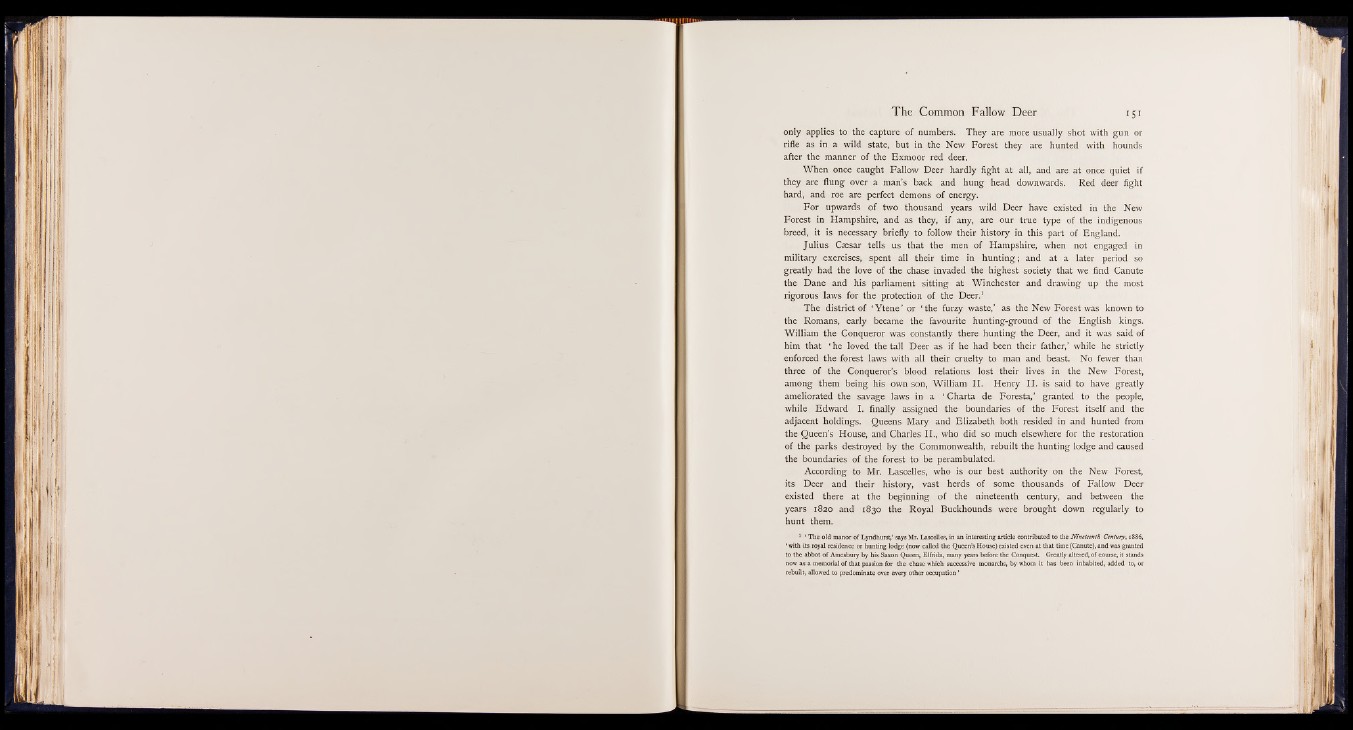
only applies to the capture of numbers. They are more usually shot with gun or
rifle as in a wild state, but in the New Forest they are hunted with hounds
after the manner of the Exmoor red deer.
When once caught Fallow Deer hardly fight at all, and are at once quiet if
they are flung over a man’s back and hung head downwards. Red deer fight
hard, and roe are perfect demons of energy.
For upwards of two thousand years wild Deer have existed in the New
Forest in Hampshire, and as they, if any, are our true type of the indigenous
breed, it is necessary briefly to follow their history in this part of England.
Julius Caesar tells us that the men of Hampshire, when not engaged in
military exercises, spent all their time in hunting; and at a later period so
greatly had the love of the chase invaded the highest society that we find Canute
the Dane and his parliament sitting at Winchester and drawing up the most
rigorous laws for the protection of the Deer.1
The district of 1 Ytene ’ or ‘ the furzy waste,’ as the New Forest was known to
the Romans, early became the favourite hunting-ground of the English kings.
William the Conqueror was constantly there hunting the Deer, and it was said of
him that ‘ he loved the tall Deer as if he had been their father,’ while he strictly
enforced the forest laws with all their cruelty to man and beast. No fewer than
three of the Conqueror’s blood relations lost their lives in the New Forest,
among them being his own son, William II. Henry II. is said to have greatly
ameliorated the savage laws in a ‘ Charta de Foresta,’ granted to the people,
while Edward I. finally assigned the boundaries of the Forest itself and the
adjacent holdings. Queens Mary and Elizabeth both resided in and hunted from
the Queen’s House, and Charles II., who did so much elsewhere for the restoration
of the parks destroyed by the Commonwealth, rebuilt the hunting lodge and caused
the boundaries of the forest to be perambulated.
According to Mr. Lascelles, who is our best authority on the New Forest,
its Deer and their history, vast herds of some thousands of Fallow Deer
existed there at the beginning of the nineteenth century, and between the
years 1820 and 1830 the Royal Buckhounds were brought down regularly to
hunt them.
1 ‘ The old manor of Lyndhurst,’ says Mr. Lascelles, in an interesting article contributed to the Nineteenth Century, 1886,
‘ with its royal residence or hunting lodge (now called the Queen’s House) existed even at that time (Canute), and was granted
to the abbot of Amesbury by his Saxon Queen, Elfrida, many years before the Conquest. Greatly altered, of course, it stands
now as a memorial of that passion for the chase which successive monarchs, by whom it has been inhabited, added to, or
rebuilt, allowed to predominate over every other occupation ’